This month, Dr. Toon makes the argument that HarveyToons do hold a more significant place in toon history than is usually afforded them.
I don't want to scare people! I just want to make friends!
AAGGHH! A GHOOOOOOOOST!
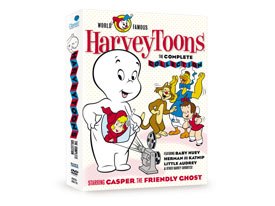
The holiday season was a wonderful time for DVD enthusiasts. Boxed sets bonanzas and slews of series made their way to digital disks, and animation fans of all stripes delighted in obtaining previously unreleased gems, both old and new. From those annual treats from the Disney archives to the uninspired dross that was Tennessee Tuxedo, there was truly something for everyone who sent letters to Santa this year. One underpriced set, which attained some notice but flew largely under the radar, was HarveyToons: The Complete Collection, compiled by Classic Media.
The title is somewhat of a misnomer: Not all of these cartoons are originally HarveyToons, and the collection is far from complete. This set, however, consisting of four double-sided discs, is one of the more important historical artifacts released last year. It is true that these cartoons were dismissed by countless critics in comparison to finer work done at other studios. However, I intend to make a case that these cartoons do matter, especially to those of us with an interest of animation appreciation and cartoon history. Let us begin, as always, with the back-story.
The Fleischer studio, birthplace of Betty Boop, as well as the first animated versions of Popeye the Sailor and Superman, went down in a hail of debt to Paramount Pictures in January of 1942. Max and Dave Fleischer, the now-bickering brothers who founded the studio were ousted, and Paramount now owned every writer, animator, inker and painter in the stable. This still-formidable staff included some of the most respected artists in the business: on board were Dave Tendlar, Johnny Gentilella, Orestes Calpini, Jim Tyer, Nick Tafuri and Myron Waldman, to name just a few. At one point, the legendary Bill Tytla would be on the Famous creative team.
Voice artists included the venerable troika of Jack Mercer, Jackson Beck and Mae Questal, who continued their fine work on the ongoing Popeye series, as well as versatile radio comedians Arnold Stang and Sid Raymond. Overall supervision of the studio, now renamed Famous, was in the hands of Fleischer veterans Sam Buchwald, Izzy Sparber and Seymour Knietel. By 1944, all Famous cartoons were finally produced in Technicolor, and the future looked to be stronger than a sailor on spinach.
Famous first attempted to make a star out of Marge Buell Henderson's comic strip character Little Lulu, but dropped the curly moppet in 1948. It was easier and cheaper to replace her with an in-house character named "Little Audrey" than continue to pay for the rights to Lulu. In 1945, story man Seymour Reit and animator Joe Oriolo sold an idea for a one-shot cartoon to Famous president Sam Buchwald. The star was a friendly little ghost named after a comic strip character, Casper Milquetoast. By 1950, Casper the Friendly Ghost was the star of his own series; he would be the most popular character to emerge from Famous.
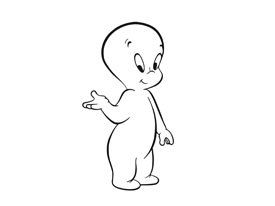
A mouse called Herman starred in an early series as pal to a henpecked rooster, but when he was paired with a vicious, stupid feline named Katnip, both characters became popular mainstays as well. With Arnold Stang and Sid Raymond doing the respective voices of Herman and Katnip, the results were vastly entertaining. Buzzy the Funny Crow (who could not pass muster in today's politically correct world of animation) had some great turns with Katnip as well.
Animator Marty Taras contributed the dopey star Baby Huey (also voiced by Raymond), who is best described as the Incredible Hulk among his fellow ducks. Old stars, such as Spunky the mule appeared in the studio's Noveltoons shorts along with more recent creations, such as Tommy Tortoise and Moe Hair (one has to love that pun!)
Still, despite the talent and money involved, something about the cartoons is not quite right. Part of the problem may have been the studio's location in New York, far from the animation scene in Hollywood. The Famous staff became imitative of what they believed worked at Disney, Warner Bros. and MGM. The Famous cartoons of the 1950s were essentially replications of shorts made in the 1940s. Repetition and reuse of gags is highly evident -- to an experienced animation buff, they seem to be telegraphed in advance.
The UPA influence, which shook the conventions of how American animation used design, did not register any impact on Famous until perhaps seven years after other studios began to alter their styles. There is no better example than the Casper short True Boo (1952). Compare the design for the young boy and his mother in this short with that of the character of Gerald McBoing Boing, who made his debut a year earlier, Mrs. Mc Boing Boing. Worse, the plot and action in True Boo are direct lifts from the Fleischer cartoon Christmas Comes but Once a Year -- released in 1936.
By 1956, the end was in sight. Famous was liquidated, then revived as Paramount Cartoon Studios. Its many characters were sold, with rights in perpetuity, to Harvey Comics. Paramount severely slashed the budgets for new cartoons, and a similar move occurred with personnel. Finally, production stopped on the Popeye shorts. The fall of the house of Fleischer was complete. No Famous cartoon, in the entire history of that studio, ever garnered an Oscar nomination. Unless one was a comicbook aficionado, Little Audrey, Herman and Katnip, and Baby Huey faded into obscurity.
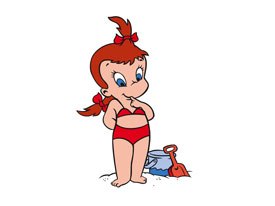
What is there to be gleaned from the wreckage of various Famous cartoons, Noveltoons, HarveyToons and Modern Madcaps? According to animation author and cartoon buff Jerry Beck, plenty. "Keep in mind," Jerry Beck observed, "the Paramount cartoons, like Warner, Disney and MGM, were made by an "A" studio and that these were "A" cartoons. It came down to budget, and Paramount had high budgets and a first-class operation. The animation is superb, and you can see that. Paramount cartoons had good art, good design and good animation. They are definitely worthy of study."
Jerry Beck further notes that "The studio really kick-started for a brief time in late 1957 (when the UPA influence finally began to make inroads). You begin to see really cool backgrounds and stylized character designs. It was a short-lived renaissance, but they were as good as any other studio's at that point. Occasionally they did experimental things. Take a look at Bouncing Benny (1960); it's actually cutout animation, just like South Park." Jerry Beck's observations can also be borne out with a look at Okey-Dokey Donkey (1958) and its startling graphic take on Spunky, or the sophisticated backgrounds in the Casper cartoon Spooking About Africa (1957) among others.
Besides, added Jerry Beck, "They're fun, like sitting down with a pint of Haagen-Dazs and a bag of chips! I love listening to Sid Raymond's voice. I love Arnold Stang. They are doing real acting and performing in these cartoons, and they created great vocal characters. Baby Huey and Katnip are very funny characters. There are some good stories in some of the Little Audreys, and there are some great Caspers. There's an art and professionalism to most of the HarveyToons. Don't forget, these were essentially the same guys who worked on Gulliver's Travels. There's gold to be mined -- even if you have to pan a lot of fool's gold first."
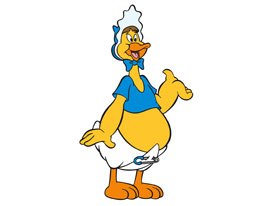
Very good points, indeed. For my own part, I saw perhaps all of the cartoons on these discs at one time or another while I was growing up, particularly when the HarveyToons were regularly featured on television. Even then, it struck me that I was looking at shorts that were almost reductive in nature, as if they had been produced by people who understood what cartoons were and what they were supposed to do, but for some reason could not match up the ingredients in the correct order or amounts. They are, rather, quasi-cartoons, especially some of the Modern Madcaps and Noveltoons. They are animated, they have characters, but there is an unsettling emptiness that runs through many of them. For all their production quality, these cartoons are eerily generic.
Jerry Beck, in pondering this phenomenon, related to me that, "Famous had what I call, 'The Shemp Effect.' By the time Shemp joined the Three Stooges in the 1950s, the Stooges had forgotten what made slapstick humor so funny, like it was with Curly in the '40s. When Shemp joined, the poking and hitting became violent. It became more cruel than humorous, and it wasn't as funny anymore. There was just something weird about the violence. That's Herman and Katnip. The guys at Famous studios in New York City could only go to the theaters and see these successful Tom and Jerry cartoons and try to figure out what was so funny. They saw that people got a laugh when Tom was hit with an iron and his face came out shaped like one, but it was more than that. It's the way it was done, the timing and direction, and the Famous crew didn't get that. So they put in all these incredibly violent gags and they just don't play."
After our conversation, it came together for me, especially why these cartoons looked so different then and still do today. I now realize why HarveyToons matter and why any serious animation fan should buy and review everything in the set: The HarveyToons are a stark template for the rules of American theatrical animation, with its most simple conventions nakedly on display. They are six minutes of basic, generic, Hollywood cartooning, stripped-down skeletons compared to the more sophisticated cartoons produced at other studios during the same period. The HarveyToons do, however, have production values that keep them from being the visual equivalent of their writing and direction, and thus one's attention is held despite the many conceptual flaws on display.
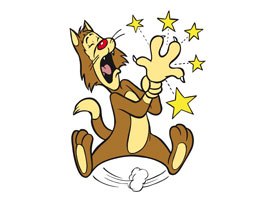
In short, the HarveyToons are what cartoons from 1950-60 are in their most elemental forms. Occasionally they may surprise and give more, but mostly they give less. They are not truly weak imitations of Disney, Warner, or MGM cartoons. It would be closer to the truth to say that the HarveyToons are lesser representations of them with equal budgets. There is something sweetly sad about the Famous cartoons; like their star, Casper. They were cute, friendly and worked hard to be accepted, but they were ghosts of what real cartoons would have been at the other A-budget studios.
Because of this, they are invaluable. If you were a kid and you were watching these HarveyToons in any given order, without any thought to direction, pace, story, or timing, you would be getting an education in the basic language of the American theatrical cartoon. If you were to further your growth as an animation aficionado, scholar, or critic, you would begin with this collection; in order to appreciate the most significant work created at Disney, UPA, MGM or Warner, you would first watch and analyze the Famous output. Consider that the writers on The Simpsons have acknowledged that their inspiration for Itchy and Scratchy, the most reductive and violent chase cartoon ever conceived, was Herman and Katnip cartoons.
The day of the theatrical cartoon is long over. Nearly everyone who labored on the HarveyToons has passed on. Paramount closed its animation studio in 1967. Harvey Comics, the last home of many Famous characters, is likewise defunct, although the indefatigable Casper marches on in various media. The HarveyToons collection, in fact, was carelessly tossed out into the market without extras, commentaries, or even so much as an episode guide.
As Jerry Beck ruefully commented, "It's as if the customer is Mom, going to Wal Mart, picking it up and saying, 'Oh, here's a big collection of cartoons! I'll just bring it home, put it on, and let the kids watch it all afternoon while I'm busy making the turkey.' With no care and no love for what the product is. It seems like it was just designed to be a babysitter."
Jerry Beck is right; in truth, the HarveyToons collection is a lost opportunity.
Unless someday one of those kids in front of the TV begins to muse, "I've never seen these cartoons before! I wonder who made them..."
Martin "Dr. Toon" Goodman is a longtime student and fan of animation. He lives in Anderson, Indiana.







